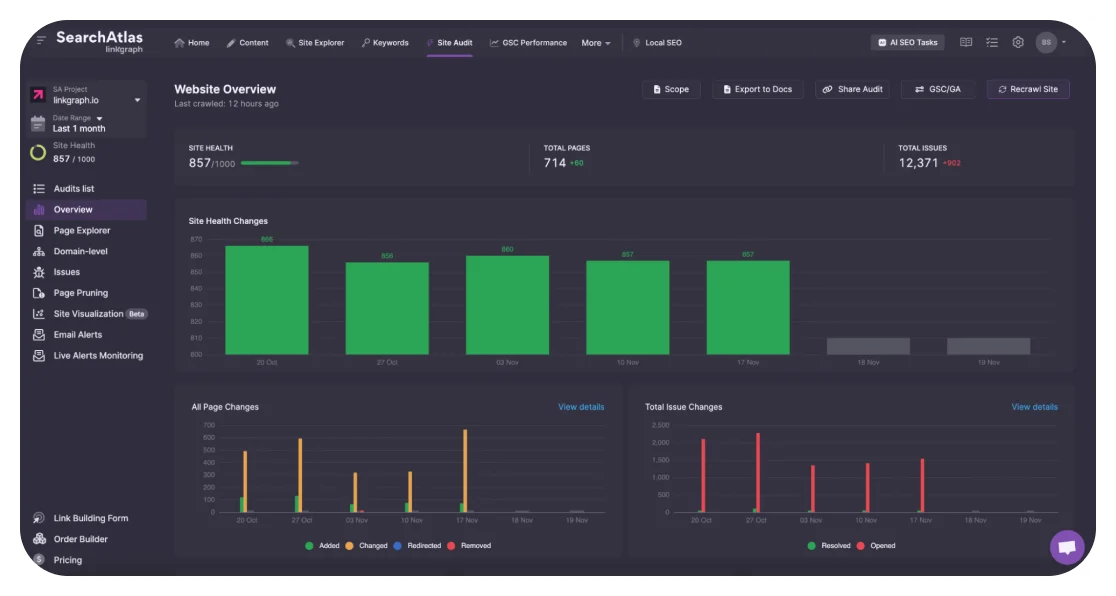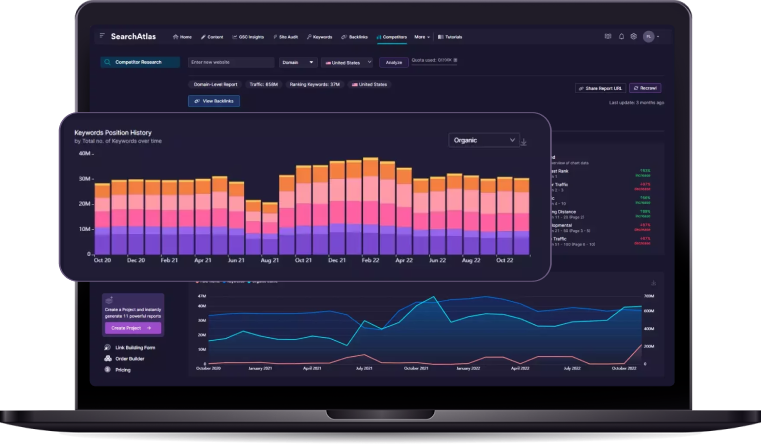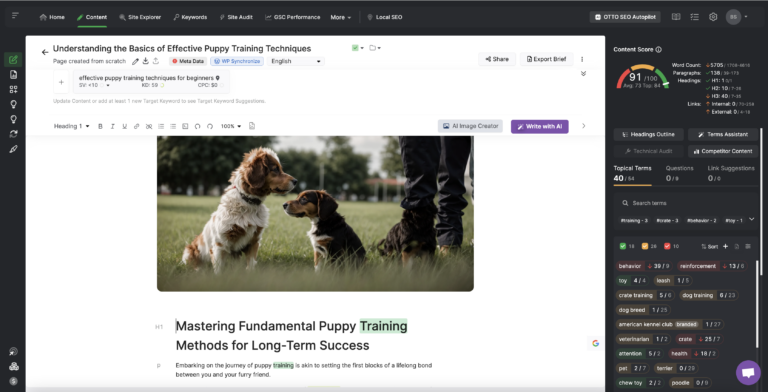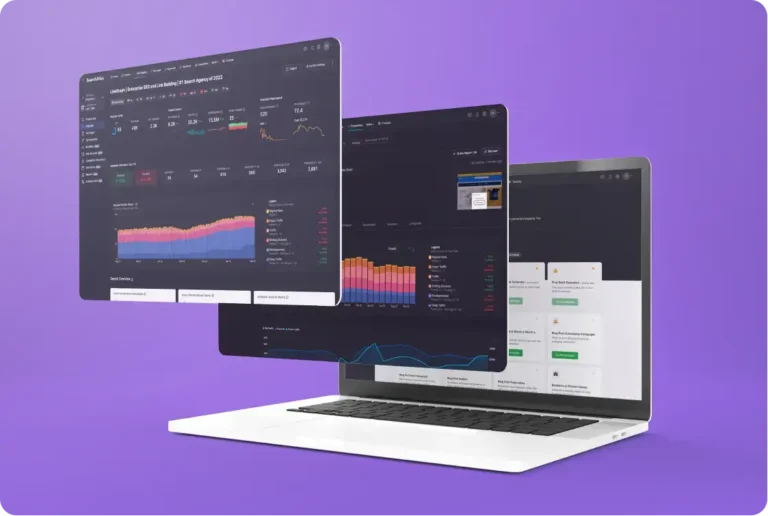Optimizing for Success: Mastering Technical SEO and Boosting Website Speed
In the dynamic digital age, a website’s visibility hinges on meticulously honed technical SEO and brisk website speed.
As search engines increasingly prioritize user experience, website owners must leverage a comprehensive toolbox—like Search Atlas’ suite of SEO tools— to finesse site speed and satisfy the sophisticated algorithms that propel their search engine rankings skyward.
Acknowledging this, business success now requires a deep understanding of the nuances of mobile optimization, secure hosting, and innovative caching solutions.
Revealing the intricate weave of these components, professionals who master them often witness a surge in page views, customer satisfaction, and conversion rates.
Keep reading to uncover how you can transform your website into a performance powerhouse that captivates both search engines and consumers alike.
Key Takeaways
- Technical SEO Is Fundamental for Website Performance and Search Engine Rankings
- Site Speed Optimization Enhances User Experience and Can Be Achieved Through Various Practices
- Regular Server Performance Audits and the Right Hosting Solutions Are Crucial for Website Stability and Speed
- Caching Strategies, Including Server-Side and Service Workers, Play a Significant Role in Performance Optimization
- A/B Testing Is Essential for Determining the Most Effective Optimizations for Improving Site Speed and User Engagement
Unveiling the Essentials of Technical SEO for Better Ranking

In the digital cosmos where visibility can signify triumph or obscurity, Technical SEO stands as a pivotal cog in the mechanism of online success.
An intricate tapestry of strategies, it encompasses every tech-infused effort geared towards enhancing a website’s underpinning architecture, thereby bolstering its standing with discerning search engines.
With website speed taking center stage in the pageantry of SEO metrics, website owners are turning their attention to the finer details that dictate Technical SEO.
From the methodical process of a Technical SEO audit to the thoughtful structuring of site hierarchy, the crafting of precise XML sitemaps, the strategic use of Robots.txt files to the calculated employment of Schema markup, and the savvy canonicalization to prevent Content Duplication—these elements converge to create an optimized digital platform.
By unraveling these aspects, enterprises lay the foundation for search engines to effortlessly crawl and index their content, enhancing visibility and culminating in an indelible imprint on search results.
Understanding the Fundamentals of Technical SEO
Grasping the fundamentals of Technical SEO demands a meticulous understanding of the digital framework upon which websites are built. This encompasses a confluence of expert-level knowledge in website coding, server optimization, and the rigorous application of SEO principles that align with the constantly evolving algorithms of search engines.
For those eager to elevate their digital presence, a keen emphasis on the core aspects such as Optimizing robots.txt to guide search engine crawlers, enhancing the XML sitemap for improved indexation, and ensuring efficient site structure offers a fertile ground for consequential search engine ranking improvements. Mastering these cornerstones is essential for any website intent on achieving optimal online visibility and user engagement.
Conducting an in-Depth Technical SEO Audit
An in-depth Technical SEO audit is the cornerstone for any website seeking to optimize its presence on the digital stage. It is a comprehensive analysis that lays bare the structural integrity of a website, pinpointing areas of improvement that could be inhibiting its performance in search engine rankings.
During this meticulous examination, specialists scrutinize an array of pivotal factors including site speed, responsiveness, internal linking structure, and security protocols. By addressing these key components, a website can enhance its harmony with search engine guidelines, cementing a robust foundation for future SEO endeavors:
| Technical SEO Component | Common Issues | Benefits of Optimization |
|---|---|---|
| Site Speed | Unoptimized images, excessive scripting | Faster load times, better user experience |
| Mobile Responsiveness | Poorly configured viewports, clickable elements too close | Increased mobile traffic, improved rankings |
| Internal Linking | Broken links, unclear navigation paths | Better crawlability, easier indexation |
| Security | Lack of SSL, exposed data | Secure user data, trustworthiness |
Structuring Your Site Hierarchically for Optimal Crawling
The architecture of a website reigns supreme in the realm of Technical SEO, impacting its ability to be seamlessly crawled by search engine bots. A logically structured hierarchy not only ensures content is presented in an organized manner, but also aids search algorithms in understanding the relative importance of pages and how they interconnect within the website’s overall framework.
By meticulously optimizing website structure, with a clear and coherent category and sub-category system, businesses facilitate the crawling process for search engines. This orderly configuration allows users and electronic visitors alike to navigate effortlessly, enhancing the user experience and signaling to search engines the high-quality nature of the website’s informational architecture.
The Importance of XML Sitemaps and Robots.txt Files
Stewarding search engines through a website’s digital landscape, XML sitemaps serve as quintessential guides. These comprehensive charts present a clear blueprint of a site’s content, ensuring that no page remains uncharted territory for search crawlers, thus expediting the indexation process and enhancing a site’s visibility.
Complementary to sitemaps, Robots.txt files stand as the vigilant gatekeepers of a site’s back end. They direct search engine bots towards areas ripe for exploration while barring access to non-essential sections, fortifying a website’s operational efficiency and safeguarding against the unnecessary squandering of crawl budget.
Implementing Schema Markup to Enhance Visibility
Boosting online visibility achieves new heights with the judicious application of Schema markup. This technology allows website owners to provide search engines with detailed insights about the content’s context, paving the way for enhanced search result displays that capture user attention.
By embedding this metadata, sites become more intelligible to search algorithms, which translates into more prominent and informative appearances in the search results. Such visibility gains hold great potential for drawing increased engagement, thereby influencing the website’s click-through rates positively.
Leveraging Canonicalization to Avoid Duplicate Content
Leveraging canonicalization is a sound strategy to mitigate the impact of duplicate content which can muddle search engines and dilute ranking potential. By designating a canonical URL, website owners signal to search engines the preferred version of a page, ensuring that the link equity from similar or identical pages is appropriately consolidated.
As visitors traverse a website, encountering similar product pages or content published across multiple URLs can lead to confusion and a diminished user experience. Canonicalization directs the traffic toward the most relevant and authoritative page, thus enhancing clarity for both users and search engines:
- Canonical tags help prevent split link equity and keyword cannibalization.
- They consolidate ranking signals and direct SEO efforts to the page intended to rank.
- Implementing these tags ensures that each piece of content is indexed uniquely, preserving the site’s thematic integrity.
This technique is not just a preventative measure against potential penalties from search engines for duplicate content but also a strategic enhancer of a site’s user experience and SEO performance. Through careful canonical tag management, businesses reinforce their content’s uniqueness, fostering stronger relevance and authority in their niche.
The Ultimate Guide to Accelerating Your Website Speed

In an increasingly competitive digital market, the acceleration of website speed is not just a convenience—it is a necessity for any brand aiming to capture customer attention and gain an edge over its competitors.
Technical SEO serves as the backbone of this pursuit, and optimizing website speed is a critical facet in this comprehensive strategy that can significantly influence both search engine rankings and user satisfaction.
Delving into performance insights through Core Web Vitals assessment, reducing load times by optimizing image sizes, and minifying resource-intensive code are fundamental practices that can lead to marked improvements.
Moreover, the strategic implementation of browser caching protocols and the deployment of a Content Delivery Network can offer both a localized and a global speed boost, while prioritizing above-the-fold content aligns with the user’s immediate needs for a seamless digital experience.
Analyzing Core Web Vitals for Performance Insights
Analyzing Core Web Vitals offers a window into the user experience provided by a website, with metrics that reflect real-world usage scenarios. These insights encapsulate the essence of performance, helping website owners to pinpoint and remedy interactive delays, visual stabilities, and loading inefficiencies.
By conducting a thorough evaluation of these vital statistics—such as Largest Contentful Paint (LCP), First Input Delay (FID), and Cumulative Layout Shift (CLS)—businesses gain crucial intelligence to enhance site performance:
- LCP measures the load time of the main content, focusing on speed and user satisfaction.
- FID assesses interactivity and the time it takes for a site to respond to user input.
- CLS evaluates visual stability, ensuring a page’s layout does not unexpectedly shift during viewing.
Optimizing Image Sizes to Reduce Load Times
Optimizing image sizes emerges as a notable strategy for reducing website load times, directly improving user engagement and SEO performance. Large, unoptimized images can become a major bottleneck, decelerating page responsiveness and testing the patience of users eager for quick information access.
Businesses that prioritize the compression and proper formatting of visual assets invariably experience the dividends in the form of enhanced site speed. By employing advanced image formats like WebP or JPEG XR, that offer superior compression with negligible quality loss, enterprises can keep their websites agile and responsive across various devices and connection speeds.
| Optimization Technique | Image Format | Estimated Size Reduction |
|---|---|---|
| Compression | WebP, JPEG XR | Up to 30-40% |
| Resizing | JPEG, PNG | Up to 50-60% |
| Lazy Loading | Browser-Dependent | Varies |
Minifying CSS, JavaScript, and HTML Resources
Minification is a process that serves as a linchpin for speed optimization, targeting the bloat that can accumulate in CSS, JavaScript, and HTML resources. By stripping away all unnecessary characters, such as comments, whitespace, and newline characters, minification ensures that a website’s payload is as lightweight as possible, fostering faster page load speeds and a smoother user experience.
Professional web developers often leverage optimization tools specifically designed to minify these resources without sacrificing functionality. The user encounters a more streamlined site, while the web server experiences a reduction in the number of network requests needed to render a page, a dual advantage that propels both website performance and search engine positioning.
Leveraging Browser Caching for Faster Reloads
In the quest for supreme website performance, leveraging browser caching emerges as a formidable ally. This clever technique instructs a user’s browser to store certain components of a website, such as stylesheets, images, and JavaScript files, thus dramatically reducing the volume of data transferred during subsequent visits.
Through this stratagem, return visitors enjoy swifter page reloads, as their browsers can retrieve the cached content from local storage rather than downloading afresh. It’s a nuanced performance optimization tactic that not only elevates speed but also elevates the user experience, leading to enhanced customer satisfaction and loyalty.
Utilizing a Content Delivery Network (CDN) for Global Reach
Expanding a website’s horizon across the global stage necessitates the use of a Content Delivery Network (CDN), a strategic advantage for businesses aiming to cater to a dispersed audience. A CDN minimizes latency by caching content in multiple geographical locations, ensuring that user requests are routed to the nearest server, resulting in faster content delivery and improved site speed.
By adopting a CDN, companies ensure their users, irrespective of location, receive an optimized browsing experience, thus upscaling user satisfaction and retention. This network of servers not only accelerates content distribution but also bolsters website resilience, deftly handling traffic spikes and reducing the load on the origin server, which solidifies the website’s performance and reliability.
Prioritizing Above-the-Fold Content to Increase User Engagement
Engaging users from the moment they land on a website is paramount, and the strategic placement of above-the-fold content plays a critical role in this endeavor. By presenting compelling visuals, captivating headlines, and immediate value propositions in this prime digital real estate, websites cast the first and possibly most important hook to capture user attention and encourage further exploration.
Understanding that the initial viewport is the user’s window into a website’s offerings, savvy website owners leverage this space to deliver a rapid, responsive experience. Proper optimization ensures that key messages load with alacrity, fostering instant connectivity with the audience and setting the stage for user engagement that potentially cascades into tangible business success.
Advanced Techniques for Mobile Optimization

Embracing the mobile-first approach has become a clarion call for businesses seeking prominence in the digital realm, as Google’s Mobile-First Indexing Initiative reshapes the landscape of search prioritization.
This shift underscores the pressing need for websites to optimize for mobile engagement—a realm where speed and user experience are inexorably linked to success.
Honing responsiveness across varied devices, reducing mobile-specific load impediments such as redirects, and adopting technologies like Accelerated Mobile Pages (AMP) represent the advanced techniques that elevate a mobile website’s user journey to one of seamless access and instantaneous interaction.
Adapting to Google’s Mobile-First Indexing Initiative
Adapting to Google’s Mobile-First Indexing Initiative is an imperative move for businesses intent on maintaining and enhancing their competitive edge. This shift by the tech giant places precedence on the mobile version of a website as the primary source for indexing and ranking, thereby making the performance on mobile devices a quintessential aspect of a website’s SEO strategy.
Companies must ensure their websites are fully optimized for mobile, presenting an interface that is as intuitive and fluid as it is on desktop. This involves meticulous site design modifications, compression of media files, and a focus on touch-friendly navigation features, thereby aligning with Google’s framework for assessing and serving the most relevant and user-friendly content.
Fine-Tuning Responsive Design for Cross-Device Compatibility
In the realm of digital engagement, fine-tuning responsive design for cross-device compatibility is a deliberate and methodical process that reflects commitment to user inclusivity. Businesses must ensure that their digital offerings cater to a diverse array of devices, from smartphones to tablets, ensuring a cohesive experience that adapts fluidly to varying screen sizes and resolutions.
Responsive design hinges on a flexible grid system, media queries, and adaptable images that work in concert to provide a seamless transition across devices. By prioritizing these responsive design principles, businesses underscore their dedication to providing an equitable digital experience, regardless of the device employed by users:
- A flexible grid-based layout ensures structural adaptability across devices.
- Strategic use of media queries allows content to respond to different screen properties.
- Adaptable images scale without distortion, maintaining visual integrity.
Minimizing Redirects to Expedite Mobile Loading Speed
Redirects, while occasionally necessary for maintaining site structure and user navigation, can become a speed impediment for mobile users. Each redirect potentially initiates an additional HTTP request-response cycle, delaying the delivery of content and compromising mobile load performance.
Content professionals and web developers aim to flatten website architecture where possible, thereby reducing the reliance on redirects. This approach streamlines the path users and search engine crawlers take to reach the desired content, facilitating a more immediate connection with minimal loading interruption:
- Analyze the current redirect chains to identify opportunities for consolidation.
- Implement direct links in navigation to cut down on unnecessary redirects.
- Employ server-side configurations to manage essential redirects efficiently.
Implementing AMP for Instantaneous Mobile Page Loads
Implementing Accelerated Mobile Pages (AMP) stands at the forefront of performance optimization for mobile devices, representing a stride toward instantaneous page loads. This open-source framework, designed to streamline content and improve overall mobile performance, equips websites to deliver lightning-fast experiences to on-the-go users.
Adoption of AMP is a strategic choice, offering visitors near-instantaneous access to web content by optimizing various elements like HTML tags, JavaScript libraries, and network requests. The technology pre-renders information, reduces page complexity, and leverages Google’s cache to deliver content at breakneck speeds:
- Optimized HTML ensures faster rendering by stripping away non-essential code.
- Standardized JavaScript libraries by AMP create uniformity in functionality and speed across mobile web pages.
- Google’s AMP Cache serves cached content to users, markedly diminishing load times and resource requests.
Unlocking the Power of Secure, Fast Hosting Solutions

In the quest for a formidable online presence, selecting the right hosting solution is a critical determinant of a website’s speed and reliability.
For business owners and web developers alike, this decision carries the weight of their brand’s digital prowess.
Evaluating hosting providers demands a sharp eye for detail to discern the offerings that promise top-tier performance.
Meanwhile, cloud hosting emerges as a progressive option, with its scalable resources tailored to meet diverse performance demands.
To ensure sustained efficiency, regular server performance audits are essential, providing valuable insights for strategic enhancements.
Additionally, embracing modern protocols such as HTTP/2 opens up new avenues for reducing website load times.
Each of these facets underscores the intricate relationship between hosting solutions and the omniscient goal of SEO mastery—where speed and stability form the backbone of success.
Evaluating Hosting Providers for Speed and Reliability
Choosing the right hosting provider is akin to laying a solid foundation for a skyscraper; it is indispensable for ensuring the website stands tall against the torrents of digital traffic and performance pressures. Companies should prioritize hosts with proven uptimes and the capacity to manage bandwidth surges, as these are critical metrics that directly affect a website’s accessibility and user experience.
Investigating the server technologies and performance optimization features offered by hosting services is crucial in the pursuit of reliability and speed. A provider that integrates advanced features such as solid-state drives (SSDs), content delivery networks (CDNs), and the latest caching technologies will arm the website with the speed it needs to satisfy the modern user’s need for rapid content delivery.
Investigating the Benefits of Cloud Hosting for Performance
Cloud hosting harnesses the potential of distributed resources, offering businesses an agile environment that dynamically scales according to website demand. By leveraging a network of remote servers, cloud hosting provides a resilient structure where resource allocation can be adjusted in real time, mitigating the risk of downtime and ensuring seamless user experiences.
This hosting methodology not only fortifies a website against traffic surges but also spells efficiency in performance. Sophisticated load balancing distributes site requests across multiple servers, reducing the strain on any single machine and enhancing overall speed:
- Scalability ensures the website handles sudden traffic increases without compromising performance.
- Load balancing techniques distribute traffic evenly to prevent server overload.
- Redundancy protocols protect against data loss and ensure continuous website availability.
In the pursuit of technical excellence, the adoption of cloud hosting emerges as a strategic asset. It invites businesses to partake in an elastic web infrastructure that supports the swift delivery of digital content, fostering not only user satisfaction but also aiding in the optimization of SEO efforts through improved website responsiveness and uptime.
Emphasizing the Need for Regular Server Performance Audits
Regular server performance audits are not just routine check-ups; they are essential diagnostic tools that uncover the nuances of website performance. By systematically evaluating server response times, resource usage, and downtime incidents, businesses ascertain the wellness of their hosting environment, ensuring that it remains conducive to high-speed delivery and stable user experiences.
Armed with the insights from these audits, companies advance proactively, implementing necessary enhancements to server configuration and website architecture to preempt potential performance setbacks. Such vigilance fosters an environment where website speed and uptime can thrive, fundamental tenets of creating a robust online presence:
| Audit Focus | Purpose | Impact |
|---|---|---|
| Server Response Times | Assessing the swiftness of server reactions to requests | Improved efficiency, reduced bounce rates |
| Resource Usage | Identifying areas of excess resource consumption | Optimized performance, scalability |
| Downtime Incidents | Understanding frequency and causes of service interruptions | Increased reliability, bolstered user trust |
Understanding the Impact of HTTP/2 on Website Loading Speed
Grasping the intricacies of HTTP/2 equips businesses with a formidable tool to enhance their website’s loading speed. This advanced protocol introduces multiplexing, allowing multiple requests to be sent over a single connection simultaneously, which significantly minimizes the latency that plagued its predecessor, HTTP/1.
With HTTP/2, web developers can expedite content delivery without compromising security, as this protocol supports efficient encryption through TLS. The result is a swifter, more streamlined browsing experience that aligns with present-day user expectations and contributes to favorable search engine rankings.
Streamlining Website Performance With Modern Caching Techniques

In a digital era where milliseconds can make the difference between a satisfying user experience and a lost visitor, harnessing the power of modern caching techniques becomes imperative for website performance optimization.
Addressing the need for speed, savvy website administrators focus on configuring server-side caching for dynamic content, exploring a plethora of caching mechanisms, and employing service workers to spearhead progressive web app (PWA) caching strategies.
These advancements in caching are not just about storing static files; they represent a strategic approach to delivering swift and dynamic content that meets the consumer’s demand for instantaneous access, directly influencing engagement, and retention across a multitude of digital touchpoints.
Configuring Server-Side Caching for Dynamic Content
Server-side caching for dynamic content emerges as a revolutionary practice in the optimization landscape, establishing itself as a key determinant in the fluid delivery of personalized user experiences. By storing dynamically generated web pages, servers can quickly serve these cached versions to users, thereby reducing processing load and enhancing website performance significantly.
Proactive website owners configure caching mechanisms with precision to tackle the unique demands of dynamic content, ensuring their site’s vitality and responsiveness. This tailored approach to caching not only boosts page load speed but also fortifies site reliability, sculpting an online presence built to endure the rigors of user expectations and search engine scrutiny.
Exploring Different Types of Caching Mechanisms
In the landscape of website optimization, exploring different types of caching mechanisms is akin to charting varied courses toward the same destination: enhanced performance. Each caching method, from browser and page to object and database caching, serves a unique purpose in reducing server load and accelerating content delivery to the end user by storing versions of content that are readily accessible upon request.
Among the spectrum of caching solutions, browser caching stands out for its direct impact on individual user experience, enabling a user’s device to store elements of a website locally, while server-side options like page caching store fully rendered HTML for swift retrieval. These nuanced approaches to caching reflect a composite strategy that aligns with overarching goals of speed optimization and seamless site interaction.
Utilizing Service Workers for PWA Caching Strategies
Service workers are at the vanguard of PWA (Progressive Web App) technology, offering a robust solution for caching strategies that facilitate offline experiences and lightning-fast load times. By intercepting network requests and managing responses, these scripts operate independently from the web page, allowing developers to control how resources are cached and retrieved.
The implementation of service workers ushers in transformative caching capabilities, enabling websites to maintain performance during flaky network conditions and even when entirely offline. This pivotal feature of PWA architecture extends user engagement by ensuring that critical resources are stashed away for swift, reliable accessibility:
| Caching Aspect | Benefit | Technology Empowered |
|---|---|---|
| Offline Access | Continued functionality without a network | Service Workers |
| Resource Management | Efficient retrieval and storage of assets | Progressive Web Apps |
| Network Resilience | Steady performance in unstable conditions | Cache API |
Continuous Monitoring and Improvement of Site Speed

Remaining vigilant in the digital landscape mandates a proactive approach to the evolution of a website’s performance metrics.
It is through the meticulous process of continuous monitoring and incremental improvements that businesses can solidify their online advantage.
Setting up performance benchmarking and alerts cultivates a culture of timely responsiveness to changes in site speed, establishing a baseline for perpetual excellence.
Rigorous testing across diverse browsers ensures universal accessibility, while close analysis of user behavior unveils patterns that may suggest performance bottlenecks.
Furthermore, embracing the empirical rigor of A/B testing allows for the meticulous assessment of optimization changes, quantifying their impact on the user experience.
This holistic framework for evaluation and iteration empowers websites to reach pinnacle levels of speed and technical finesse, translating into superior search standings and user satisfaction.
Setting Up Performance Benchmarking and Alerts
Establishing robust performance benchmarking is a strategic initiative that necessitates consistent observation and analysis of a website’s speed metrics. By setting clear performance targets and regularly measuring against them, website administrators can gain actionable insights into the site’s speed across various scenarios and devices.
Alert systems serve as critical sentinels in the pursuit of uninterrupted website performance, swiftly notifying teams when speed metrics falter. Implementing these alerts ensures that any deviations from established benchmarks are rectified promptly, preserving the integrity of the user experience:
| Performance Metric | Benchmark | Alert Trigger |
|---|---|---|
| Page Load Speed | Under 3 seconds | Exceeds 3 seconds |
| First Contentful Paint | Under 1.2 seconds | Exceeds 1.5 seconds |
| Time to Interactive | Under 3.8 seconds | Exceeds 4 seconds |
Regularly Testing Site Speed Across Various Browsers
In an era where browser diversity is as vast as the user base itself, regularly testing site speed across various browsers is not a luxury but a necessity. Brands seeking robust online engagement recognize that performance can differ from one browser environment to another due to distinct rendering engines, user settings, and extension impacts.
Ensuring compatibility and consistent speed across leading browsers warrants an efficient, responsive website capable of catering to a broad spectrum of users. This practice is integral to eliminating roadblocks that could otherwise lead to increased bounce rates and diminished user satisfaction, ultimately impacting a business’s online growth trajectory.
| Browser | Speed Metric | Benchmark | Performance |
|---|---|---|---|
| Google Chrome | Time to First Byte (TTFB) | Under 1.3 seconds | Optimal |
| Mozilla Firefox | First Contentful Paint (FCP) | Under 1.5 seconds | Meets Benchmark |
| Apple Safari | Speed Index | Under 3.0 seconds | Below Expected |
| Microsoft Edge | Fully Loaded Time | Under 4 seconds | Optimal |
Analyzing User Behavior to Identify Performance-Related Issues
Deeper analysis of user behavior offers invaluable insights into performance-related issues, unveiling how visitors interact with a website’s content and infrastructure. By tracking metrics such as session duration, pages per session, and user flow patterns, website owners can identify bottlenecks that disrupt the browsing experience and precipitate early exits from the site.
Armed with behavioral data, site analysts discern not just where users lose interest but why, whether due to slow-loading elements or confusing navigation. Optimizations then become targeted, remedying specific performance pitfalls to bolster retention and conversion rates:
| Behavioral Metric | Performance Issue Indicators | Optimization Actions |
|---|---|---|
| Session Duration | Abnormally short visits on specific pages | Enhance content relevance and page load speed |
| Pages Per Session | Low interaction with multiple pages | Improve interlinking and loading times |
| User Flow Patterns | Frequent exits from the same page | Refine navigation and reduce disruptive elements |
By correlating user actions with website analytics, performance optimization transcends guesswork, evolving into a science of delivering a user-centric browsing environment. Such a targeted approach ensures the technical refinements translate directly into an enhanced customer journey and a stronger online presence.
Implementing a/B Tests to Assess Speed Optimization Changes
Embracing A/B testing signifies a commitment to empirical analysis, a strategy pivotal for website owners keen to quantify the efficacy of speed optimization changes. By experimenting with different versions of a web page, businesses can draw definitive conclusions about which adjustments yield the most impactful improvements in site speed and user experience.
These calculated tests offer a direct pathway to performance enhancement, where data-driven decisions steer the evolution of site mechanics. Comparisons between the original and modified versions shed light on the direct relationship between applied optimizations and their influence on user engagement and conversion rates:
| Version | Optimization Tested | Page Load Improvement | User Engagement Uplift |
|---|---|---|---|
| A | Image Compression | 15% | 10% |
| B | Script Minification | 20% | 15% |
| C | CSS Consolidation | 25% | 18% |
A/B testing is not simply a static process but an iterative one, driving continuous refinements and fostering sustainable advancements in performance. This methodical approach ensures that every optimization contributes to a website’s journey towards peak efficiency and user-centric design.
Conclusion
In conclusion, mastering technical SEO and boosting website speed are critical aspects for achieving online success.
By addressing the core elements of technical SEO, such as site hierarchy, XML sitemaps, and canonicalization, businesses can significantly enhance search engine visibility.
Conducting regular technical SEO audits, optimizing mobile experiences, and implementing Schema markup further improve a site’s search engine ranking potential.
Accelerating website speed is not just beneficial but necessary in the digital landscape.
Techniques like image optimization, resource minification, utilizing CDNs, and modern caching strategies, play a vital role in reducing load times and improving user engagement.
The adoption of cloud hosting and regular server audits contribute to the site’s speed and reliability, while HTTP/2 protocol advancements ensure swift content delivery.
Continuous monitoring and A/B testing for speed optimization changes are essential in cultivating an environment where technical proficiency translates to superior user experiences and, ultimately, to a more robust online presence.
By prioritizing these technical aspects and relentlessly pursuing speed enhancements, businesses can secure a competitive advantage in an increasingly digital world.









